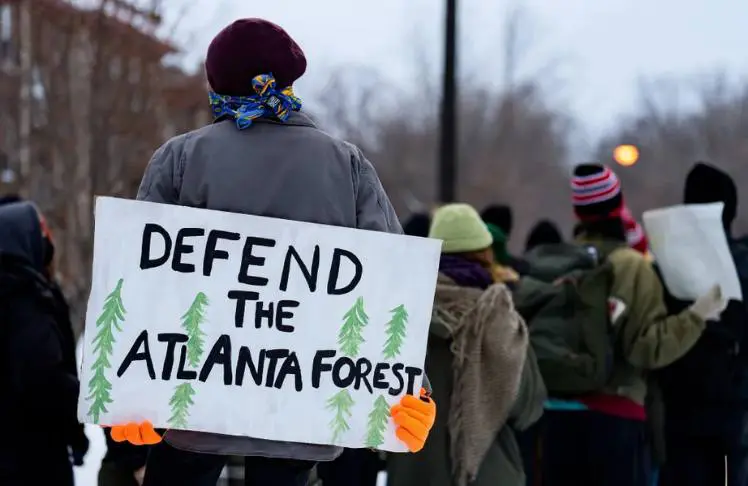
The storm that swept across Georgia earlier this week was not your average winter rain: there were tornado warnings and wind gusts as high as 65 miles per hour. Between Monday and Tuesday, as much as 4 inches of rain fell on parts of greater Atlanta.
That’s an awful lot of water, but what happened just southeast of the city was notable nonetheless: roads throughout the South River Forest flooded, at times heavily, causing at least one car crash after water on the road caused a driver to hydroplane.
It was a heavy storm, yes, but many in Atlanta see the flooding not only as a symptom of climate change, but also the ongoing construction of Cop City, the highly contentious police training facility that is currently being carved out of the country’s largest urban forest.
The flooding comes as no real surprise: Everyone from local abolitionist organizers to national environmental organizations like the Sierra Club has said that developing the forest would lead to more flooding.
Atlanta has an extensive tree canopy — it’s one of the most forested cities in the country — but the South River Forest is unique because it’s one of the rare bits of riparian woodland in the greater metropolitan area. It both absorbs water that’s draining toward the South River, which it buffers, and can also take on floodwater from the river when it is running high. But those ecosystem services provided by the woods are significantly hampered when large areas are cleared, as is happening at the Cop City site.
The rain can’t get soaked up anymore now that the trees have been cut down.
LEV OLMELCHENKO
“Atlanta generally has not done a good job of mitigating flooding throughout the city, but I do think it’s gotten worse since they cut down all of those trees,” says Lev Olmelchenko, who lives nearby the site and is working on a documentary about it called “The City in the Forest.” He saw flooding all around the forest, including by the railroad tracks directly across from the gate to the construction site, and in an area near Michelle Obama Park where the hydroplaning accident occurred.
To build the facility, an 85-acre section of forest that sits between the South River and an adjoining creek have been cleared. “The creek looked very full,” Olmelchenko says, “but probably the bigger problem is that the rain can’t get soaked up anymore now that the trees have been cut down.”
Josh Lingsch, a public defender who works in the area, photographed flooding along Constitution Rd., which runs right past the construction site. Lingsch drives through the area regularly, and said it’s probably the worst flooding he has seen there in at least six or seven years.
It’s not just people who are directly organizing around Cop City who are paying attention to water levels on the roads.
JULIAN KILROSE
While many who have been involved in the fight against Cop City have been waiting for the day when a flood like this would happen, it’s not solely a moment of schadenfreude.
“It’s not just people who are directly organizing around Cop City who are paying attention to water levels on the roads,” says Atlanta resident Julian Kilrose, who has been doing organizing around the training facility since 2021. “It’s going to be people in the area who, because of all of the organizing, are going to be like, oh yeah, they said that this could cause more flooding.”
With Cop City regularly attracting protests and other actions, including activists chaining themselves to the gates to the site or to the instruction equipment itself, there is now routinely a strong police presence in the surrounding area. Olmelchenko said it was no different when he was driving around to document the aftermath of the storm. But when he stopped and spoke to the person who had hydroplaned, the driver told him that they had been waiting for half an hour for the police to come help with the car, which had smashed into a telephone pole. “Around the corner, 30 seconds away, I saw multiple police officers sitting in their cars,” Olmelchenko says.
“This is a person who could have been very seriously injured,” he says, but the people who are tasked with maintaining public safety seemed to be in no hurry to show up. What the flooding and the accident show, Olmelchenko says, is that “the destruction of this forest is leading to a very serious public safety problem.”















